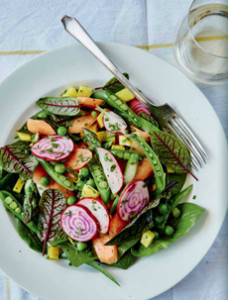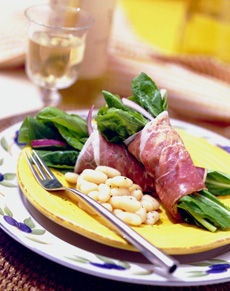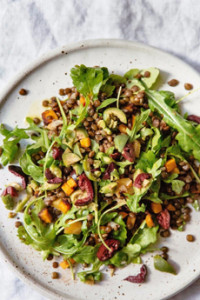TIP OF THE DAY: Eat More Legumes

|
Nutritionist advise that we eat more legumes. But most people don’t know what a legume is, so here’s an overview: WHAT ARE LEGUMES? First, some food trivia: Peas are not green vegetables, but legumes, a botanical category that includes beans, peas and lentils. They are ancient foods that have been eaten for more than 8,000 years. Man the hunter-gatherer began eating legumes as soon as he created vessels to cook them in. Back then, in the Neolithic Era, agriculture and permanent settlements evolved as nomadic hunter-gatherers realized the benefits of stable communities. As they tilled the earth, legumes were among the first cultivated crops.* Legumes used to be called “wonder foods,” now they’re “superfoods.” Versatile, they are used in soups, stews, salads, side dishes, dips/spreads and more (bean burgers and lentil cakes are yummy!). They’re also a good source of protein and fiber, low on the glycemic index, and can be a fat- and cholesterol-free substitute for meat. EATING MORE LEGUMES Nutritionists recommend that we consume up to three cups of legumes a week. They are one of the healthiest foods you can eat, and are inexpensive, too. Some people shy away from beans because they are gassy. But there’s a solution for that: Just soak the beans for several hours or overnight in cold water and change the water several times, including right before you cook them. This helps to rinse away the indigestible complex sugars that create intestinal gas. Even with beans cooked elsewhere, or those from a can: The more often you eat beans, the more your system accommodates them without digestive incident. You can get there in just three weeks of eating beans. [Source] |
|
|
Where To Start There are more than 4,000 cultivars of beans in the U.S. (and many more worldwide). See our Bean Glossary to discover some of them.
Beyond supermarket beans, take a look at heirloom beans. These are varieties grown from old strains, and have more flavor, better texture and a beautiful appearance. Due to lower yield, more demanding growing requirements or other factors, these strains have been passed by by large-scale commercial growers. Many heirloom varieties have been rescued from extinction by dedicated specialty growers. For a beautiful bean selection, check out: Their heirloom beans are sold in specialty food stores and online. They’re one of our favorite gifts for cooks. Finally, here’s a tip to help you eat more legumes in general: |
||
|
RECIPE: LENTIL, OLIVE & ARUGULA SALAD This is one of the many ways in which legumes can be combined with other ingredients for fresh, tasty results. This filling salad is both hearty and flavorful. The lentils give it a nice heartiness, and two different types of olives give it a briny punch. If you don’t like olives, substitute something you do like: cherry tomatoes, pimento, sliced gherkins, whatever. Prep time is 10 minutes, total time is 30 minutes. Ingredients For 2 Servings 1. RINSE the lentils in a sieve, then add to a pot with 2 cups of water, a few pinches of salt and a bay leaf. Bring the lentils to a simmer over medium heat and cook until tender, about 25 minutes. If all of the water is absorbed before the lentils are fully cooked, add a bit more along the way. When the lentils are done, set them aside in a mixing bowl. While the lentils cook… 2. HEAT a few tablespoons of olive oil in a pan until hot; then and add the red onions. Cook the onions for 5-7 minutes, until they’re translucent and starting to brown. At this point, add the carrots and turn the heat down to medium. 3. COOL the carrots and the onions together for 5 minutes, until they’re tender but still a bit crunchy in the center (overcooking is worse than undercooking, so take them off the heat sooner rather than later). When the carrots and onions are done, add them to the bowl with the lentils. Add the olives, squeeze in the juice of half a lemon, add a few pinches of salt and stir gently. 4. COOL the lentil mixture. When it has cooled completely, gently combine with the arugula. Add more lemon if you like, plus salt and pepper to taste. |
|
|
|
|
||






